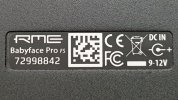Tanks for the input,
When you say that you never had any issue with powering Pro FS from USB bus alone, were your laptops plugged in or running on battery?
The idea of using an external battery for the RME is a good one. Those are sure handy in some situations. That said, I figure that if I end up plugging in my Macbook, it will give enough stable power to the RME.
Interesting point about the gain steps. I'm not at the point of recording yet—I'm still working on upgrading/updating everything in my new setup—but I'll keep an eye on that when the time comes.
Thanks for the input, Earfonia.I used Pro FS with 2 Windows laptop, never have any issue with powering Pro FS from USB bus alone. so far it is stable.
For recording my tweak is only set the ASIO buffer size to 256 samples to lower the round trip latency for overdubbing the vocal.
For my In-Ear Monitor measurement setup which I also use Pro FS, I powered the Pro FS externally using a series for 3x 18650 batteries which provides around 10-12.6 Volts. Pro FS has been stable on both scenarios of USB powered or externally powered.
This is the battery case that I use to power Pro FS externally, last very long for I think more than 10 hours. Haven't really measure how long, but from experience I think more than 10 hours.

17.14US $ 20% OFF|Waterproof 6 X 18650 Battery Storage Case Box 5v Usb / 12v/8.4v Dc Battery Pack Diy Powerbank Case Box For Bike Light Smartphone - Battery Storage Boxes - AliExpress
Smarter Shopping, Better Living! Aliexpress.comwww.aliexpress.com
My main complain with Pro FS is some of the gain steps are fake steps and doesn't really change the gain. For example, I set the IN1 gain to 20 dB. monitor the level. When I increase the gain to 21 dB, level doesn't change. When I increase again to 22 dB, then the level increased by 2 dB. So the 21 dB gain is fake gain step that actually doesn't do anything. This is just an example, I don't remember exactly which are all the fake gain steps. But I found it quite often when I use Pro FS for measurement.
When you say that you never had any issue with powering Pro FS from USB bus alone, were your laptops plugged in or running on battery?
The idea of using an external battery for the RME is a good one. Those are sure handy in some situations. That said, I figure that if I end up plugging in my Macbook, it will give enough stable power to the RME.
Interesting point about the gain steps. I'm not at the point of recording yet—I'm still working on upgrading/updating everything in my new setup—but I'll keep an eye on that when the time comes.

